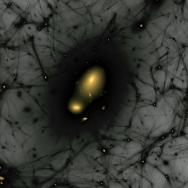Galaxies rarely live alone. Instead, dozens to thousands are drawn together by gravity, forming vast clusters that are the largest objects in the universe.
“Galaxy clusters are one of the most awe-inspiring things in the universe,” said Prof. Emeritus Don Lamb, a University of Chicago astrophysicist and co-author on a new paper published March 9—one that may point the way towards solving a decades-long mystery.
Scientists have long known that the hydrogen gas in galaxy clusters is searingly hot—about 10 million degrees Kelvin, or roughly the same temperature as the center of the sun—which is so hot that hydrogen atoms cannot exist. Instead the gas is a plasma consisting of protons and electrons.
But a puzzle persists: There is no straightforward explanation for why or how the gas stays so hot. According to the normal rules of physics, it should have cooled within the age of the universe. But it hasn’t.
The challenge for anyone trying to solve this puzzle is that you can’t exactly create these kinds of powerfully hot and magnetic conditions in your backyard.
However, there is now one place on Earth where you can: the most energetic laser facility in the world. The National Ignition Facility at Lawrence Livermore National Laboratory is able to create such extreme conditions—though only for a tiny fraction of a second in a volume the size of a dime.
Scientists from UChicago, the University of Oxford, and the University of Rochester worked together to use the National Ignition Facility—located in Livermore, California—to create conditions similar to the hot gas in gigantic galaxy clusters. “The experiments conducted at the NIF are literally out of this world,” said Jena Meinecke, who was the first author on the paper.
The scientists focused 196 lasers onto a single tiny target, creating a white-hot plasma with intense magnetic fields that exists for a few billionths of a second.
This was long enough for them to determine that instead of a uniform temperature, there were hot and cold spots in the plasma.
This dovetails with one of the theories that has been proposed for how heat is trapped inside galaxy clusters. Normally, heat would be easily distributed as electrons collide with each other. But the tangled magnetic fields inside the plasma can affect these electrons, causing them to spiral along the direction of magnetic fields—which can prevent them from evenly distributing and dispersing their energy.
In fact, in the experiment they saw that the conduction of energy was suppressed by more than a factor of 100.
“This is an incredibly exciting result because we’ve been able to show that what astrophysicists have proposed is on the right track,” said Lamb, the Robert A. Millikan Distinguished Service Professor Emeritus in Astronomy and Astrophysics.
“This is indeed an astonishing result,” added study co-author University of Rochester Prof. Petros Tzeferacos, who oversaw computer simulations of the complicated experiment. “The simulations were key to untangling the physics at play in the turbulent, magnetized plasma, but the level of thermal transport suppression was beyond what we expected.”
The simulations were done with a computer code called the FLASH code, which was developed at the University of Chicago and is now hosted at the University of Rochester’s Flash Center for Computational Science, which is led by Tzeferacos. The code allows scientists to simulate their laser experiments in exquisite detail before they do them, so that they can achieve the results they seek.
This is critical because the scientists only get a precious few shots at the facility—if something goes wrong, there’s no redo. And because the experiment conditions only last nanoseconds, the scientists have to make sure they make the measurements they need at exactly the right time. This means everything has to be precisely plotted out far ahead of time.
“It’s a challenge when you’re at the very extremes of what can be done, but that’s where the frontier is,” said Lamb.
More questions remain about the physics of galaxy clusters, however. Though the hot and cold spots are solid evidence for the impact of magnetic fields on the cooling of the hot gas in galaxy clusters, further experiments are needed to understand exactly what is happening. The group is planning its next round of experiments at NIF later this year.
For the moment, though, they’re happy to have shed light on why the gas in galaxy clusters is still hot even after billions of years.
“It’s a reminder that the universe is full of amazing things,” said Lamb.
The principle investigator on the experiment was Prof. Gianluca Gregori of Oxford University. Team members also included Oxford’s Prof. Alexander Schekochihin, Princeton’s Archie Bott, and Lawrence Livermore National Laboratory’s James Steven Ross.
Citation: “Strong suppression of heat conduction in a laboratory replica of galaxy-cluster turbulent plasmas.” Meinecke et al, Science Advances, March 9, 2022.
Funding: U.S. Department of Energy National Nuclear Security Administration, U.S. Department of Energy, National Science Foundation, European Research Council, Engineering and Physical Sciences Research Council.

